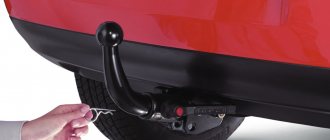Each car owner has a good idea of what his iron friend suffers during operation from the influence of the environment. When driving on roads, the body and its paintwork are especially vulnerable. Over time, chips of paint form, scratches on the body, and corrosion develops. How to protect your car or the most vulnerable body parts?
There has been armored film on cars on the market for many years now, it is also called protective or anti-gravel. It protects the entire car body or separately those places and elements that are most exposed.
Many car repair shops perform body wrapping work. Due to the simplicity of the gluing process and the relatively low cost of the material, you can carry out this operation yourself.
What kind of protective film is used and for what purposes?
Protective film is an artificial coating that protects the car body and its elements from damage. This is its main function. Additional – body styling*.
There are two types of films:
- Vinyl.
- Polyurethane.
Vinyl film was the first to be used for protection. In its physical and chemical composition, it most closely resembles plastic. It stretches when heated and when cooled turns into a hard plastic. Initially used to protect street advertising boards and billboards.
Polyurethane film has a different structure - it is soft, stretches at any temperature and returns to its original size. A synthetic polymer has properties similar to rubber. Acts as a damper*. It was developed in the USA for the needs of the Air Force, in particular, to protect helicopter blades from sand.
Essentially, both perform the same function - protecting the car body. The only difference is that vinyl protects due to its thickness, and polyurethane due to its physical properties, similar to rubber.
*styling - changing the appearance of a car... *damper - something that has a calming, softening effect...
Is it legal to paint a car?
There are certain contradictions here that mislead many car enthusiasts.
You need to know that the law does not prohibit repainting a car, but such actions must be properly documented by the traffic police. In general, as long as the car is stored in a garage, no one cares about such changes. But it will be possible to operate it only after appropriate registration. Without this, the car owner faces a fine. There is no need to take any permission in advance. The motorist must present a vehicle that has already been repainted. But you need to remember important rules. For example, it is strictly prohibited to use colors intended for ambulances, police, firefighters and other special vehicles. You should also pay attention to the places where the VIN code is stamped. You need to know that if it is painted over, traffic police officers may have unnecessary suspicions and unnecessary proceedings.
( Video : “Changing color in PTS. Car vinyl”)
Various color options
There are several options to change the color of your car. This is worth paying attention to, because further actions depend on it. So, there are three main options:
Full coloring
Often this option is chosen not just for beauty. Full painting allows you to restore the appearance of the car, for example, when the old paint is damaged and cannot protect the body from corrosion. If one color is used, there is no problem here. The already repainted car must be taken to the traffic police department for inspection. This will make the color change official. As for the combination of different colors, you need to be careful here. Some colors cannot be combined. For example, blue and white are the colors of police cars. This combination is prohibited. When a color change is made, all colors used are indicated. Similar shades are indicated by the same symbol. If the car owner wants to add something new to the design of the car, partial painting can be done.
Partial repainting
If the painting takes up less than 50 percent of the car, it is considered partial. Usually such a change does not need to be formalized. However, practice shows that recently inspectors often call this illegal actions. The thing is that the rules do not clearly explain in what specific situations partial repainting does not require registration. That is why, in order to avoid troubles, it is better to contact the traffic police department at your place of residence to find out whether your repainting needs registration. This also applies to special color films. Sometimes they may not differ from their native color. But it is also better to consult with the traffic police about whether they need to be formalized. If you use several colors, the documents will indicate the “combined” color.
Airbrush for cars
If when applying paint it is indicated that the car is “painted”, then in the case of airbrushing it is noted that it is “applied”. Many people confuse airbrushing with film. But it is not so. Airbrush is a design applied by an artist over a paint coating. Again, everything is ambiguous here. Essentially, airbrushing is just a minor change. But in order to avoid fines, in this case it is still recommended to contact the traffic police to find out whether your airbrush needs registration. The need for such consultations is explained by the fact that there are no regulatory documents on this matter. Therefore, the legality of changing the appearance of the car is determined by the inspector. Although his opinion is not always objective.
Advantages and disadvantages
When there are two or more materials for any type of work, it is always difficult to give preference to one of them. To make it easier to make a decision in our case, we can compare the positive and negative properties of both types.
Vinyl film
Advantages:
- the coating protects the car body from damage caused by dirt, fine gravel, branches and sand;
- practically invisible on the body;
- minor defects are not visible on the body;
- protects the paintwork from ultraviolet radiation;
- variety of color;
- affordable price.
Flaws:
- short service life, instead of the stated 3-5 years, only 2-3 years;
- with strong impacts with large gravel, chips and cracks appear;
- Difficulties in dismantling when the coating has been used for more than two years, the glue and film harden, removing it can lead to peeling of the paint;
- fades under the influence of the sun, reacts negatively to reagents;
- a shagreen effect is possible.
It is 100 microns (0.1 mm) thick and transparent in appearance.
Polyurethane film
Advantages:
- durable, resistant to large chips and deep scratches;
- protects the paintwork from damage caused by gravel and pebbles;
- does not undergo deformation at high and low temperatures;
- does not tear, is resistant to damage even in minor accidents;
- service life from 5 to 10 years;
- can be polished;
- protection from reagents;
- There are no difficulties during dismantling; after removal it leaves no traces.
Flaws:
- high price, five times more expensive than vinyl;
- after gluing to the body, long-term drying;
- no protection against ultraviolet radiation.
Film thickness ranges from 150 to 300 microns. There is a positive side to the fact that polyurethane allows ultraviolet light to pass through. The partially coated car body will burn out evenly, and after removing it the color will be the same.
You can remove the polyurethane coating yourself, but it is better to remove the vinyl coating in a specialized workshop, otherwise there is a risk of damaging the surface of the body.
What areas are usually protected with film?
It is best to cover the entire surface of the body. But, based on the cost, especially of polyurethane film, you can paste over the part of the body and its elements that are most exposed to sand, stones, branches, etc.
The optimal installation of protection is the front of the car:
- bumper;
- the leading edge of the hood or the entire hood;
- front wings;
- exterior mirror housings;
- leading edge of roof;
- thresholds, doors in the lower part;
- around door handles.
To this you can add the wrapping of the rear bumper, which is at risk when reversing or in heavy traffic.
An approximate partial body wrap of a Toyota Land Cruiser is shown in the photo:
Is it necessary to change the color of the PTS after pasting?
Sometimes, applying textured or colored car film can radically change the appearance of your car. And although these changes are temporary and you can always remove the coating and return to the original paint, many of our clients have a question: do they need to change the color in the PTS? Let's consider this issue from a legal point of view.
So, what should you do if you have been wanting to change the color of your car for a long time, or you are attracted to tuning with a fashionable film with a carbon effect. First of all, you should take into account that for the traffic police, wrapping a film is equivalent to painting a car, and if the color of the film differs from the original color of the car by more than 30%, then you will have to make changes to the vehicle’s passport. That is, according to the rules, owners of a red car can choose only shades of this range (cherry, coral, burgundy, etc.) However, this rule has a number of nuances, thanks to which you can safely glue the film you like and not worry about attracting attention valiant law enforcement officers.
Firstly, the color of the car is often indicated ambiguously in documents. For example, few people will be able to immediately distinguish the colors Baltic, aquamarine, lagoon and azure, although in fact they are all different shades of blue. And the colors of the film itself are difficult to describe, and owners of cars wrapped in, for example, a red-violet chameleon with a chrome effect don’t have to worry about the fact that their title is listed as one of the standard colors.
Secondly, with partial pasting, you are not required to change the color in the passport. Therefore, you can safely cover the hood, trunk or roof with film and drive for your pleasure. In addition, the car can always be covered with glossy, matte, carbon, matrix or other textured film, so that its color is close to the one listed on the title.
One of the popular ways to avoid a fine of 300 rubles. for untimely making changes to the PTS is knowledge of the simple rule that “after changing the color of the car, its owner is given 10 days to make changes to the registration documents.” And to the traffic inspector’s question about why you still haven’t changed the color on your passport, you can always say that you covered the car 5 days ago and were literally going to go to the traffic police station tomorrow.
If you are a law-abiding citizen and want to add a color change to the PTS, then this procedure will not take much time.
- At the place of registration of the vehicle, we provide our passport, PTS, and vehicle registration certificate.
- Fill out the application in the prescribed form.
- You provide the car for inspection by a traffic police inspector.
- You receive a receipt for payment of the state fee of 500 rubles. and pay for it at the nearest Sberbank terminal.
- You will receive a new vehicle registration certificate and your PTS, which will contain a note indicating that the color of the car has been changed.
So the choice is yours, but as practice shows, traffic police officers very rarely pay attention to the discrepancy between the color of a car covered with film. After all, in fact, the color of the car remains the same. And given the ten-day period for changing your passport, you don’t have to worry about finding yourself in the attention of overly vigilant inspectors.
Is it possible to cover headlights with film?
Headlight armoring is an effective means of keeping your vehicle's lighting glass in excellent condition longer. Everything is very simple: sand and pebbles flying towards the car while driving will scratch the coating, not the glass. The film can always be replaced.
From the point of view of the legislation of the Russian Federation, there was a debate - whether it is possible to paste it over or not. The dispute arose due to a discrepancy in the interpretation of Article 12.4, the Code of Administrative Offenses of the Russian Federation, the Technical Regulations on the Safety of Wheeled Vehicles, a number of GOSTs and the List of faults and conditions under which the operation of vehicles is prohibited.
Fortunately, lawyers, through judicial practice, have sorted out this issue and proved that sticking a protective film on the headlights does not change the operating mode of the device. Therefore, protecting headlights is not prohibited by Russian legislation, but the lighting devices must shine white light.
Creative-Auto
Probably, many are interested in the question of whether it is necessary to change the color of the car in the documents after wrapping the car with film (if the color has changed). After all, in fact, the color of the paintwork has not changed, only a film was applied to it. Let's look into this.
The main color of the car is the color of the body covering, which occupies the largest surface area of the vehicle (clause 5 of the Technical Regulations on the Safety of Wheeled Vehicles, approved by Decree of the Government of the Russian Federation of September 10, 2009 No. 720).
Column 9 of the vehicle passport (PTS) indicates exactly the main color of the car. If the body is painted in several colors, the passport indicates that the car is painted in a combined color (multicolor). And in this case, the document should describe the main colors used. This requirement is specified in paragraph 32 of the Regulations on vehicle passports and vehicle chassis passports, approved. by order of the Ministry of Internal Affairs of Russia, the Ministry of Industry and Energy of Russia and the Ministry of Economic Development of Russia dated June 23, 2005 No. 496/192/134.
Accordingly, from the above requirements for the color of a car, the conclusion follows - if the applied film occupies a significant part of the body area, changes must be made to the vehicle passport regarding color data.
But before submitting an application for a color change to the traffic police after wrapping a car with film and, as a result, changing the color of the vehicle, the following requirements must be met:
- the color of the repainted vehicle should not be the color of special vehicles (ambulance, fire, police, etc.)
- an application for re-registration is submitted only after the vehicle has already been repainted (in our case, pasted over)
- It is prohibited to remove the plate with the VIN code number
If all the specified requirements are met, you can begin re-issuing documents. Remember that this must be done no more than 5 days after pasting (order of the Ministry of Internal Affairs of the Russian Federation dated November 24, 2008)
The list of documents required for re-registration can be found on the official website of the State Traffic Safety Inspectorate at the following link: Changing the registration details of a vehicle (changing color, making changes to the design of a registered vehicle)
PS It is worth noting that when covering a car body with film, unlike airbrushing, you do not lose the warranty on the paintwork from the manufacturer. The film can be easily removed at any time without any damage.
Which is better, painting the body or wrapping it?
There is no clear answer to this question. Each type has its own advantages and disadvantages. Let's look at some of them.
Car body wrapping
- In terms of time, pasting is faster than painting.
- The cost of pasting is less than painting.
- The emission of harmful substances during pasting is less than during painting.
- The film preserves the paintwork.
- It is impossible to cover everything; some body shapes are easier to paint.
Car body painting
- Painting is more expensive.
- It takes more time to paint.
- High-quality painting requires specialists; it’s difficult to do it yourself.
- The paint weighs more than the film.
- Possibility of repeated polishing.
- Any part of the body can be painted.
You can accept one of the options, but if the car is new, it is better to cover it with film. If the car is used, treat its body and paint it. The decision is up to the owner.










